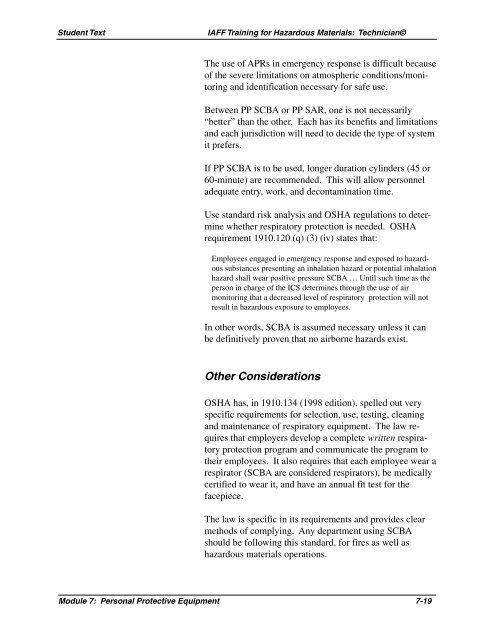Module 7 - IAFF
Module 7 - IAFF
Module 7 - IAFF
You also want an ePaper? Increase the reach of your titles
YUMPU automatically turns print PDFs into web optimized ePapers that Google loves.
Student Text <strong>IAFF</strong> Training for Hazardous Materials: Technician©<br />
The use of APRs in emergency response is difficult because<br />
of the severe limitations on atmospheric conditions/monitoring<br />
and identification necessary for safe use.<br />
Between PP SCBA or PP SAR, one is not necessarily<br />
“better” than the other. Each has its benefits and limitations<br />
and each jurisdiction will need to decide the type of system<br />
it prefers.<br />
If PP SCBA is to be used, longer duration cylinders (45 or<br />
60-minute) are recommended. This will allow personnel<br />
adequate entry, work, and decontamination time.<br />
Use standard risk analysis and OSHA regulations to determine<br />
whether respiratory protection is needed. OSHA<br />
requirement 1910.120 (q) (3) (iv) states that:<br />
Employees engaged in emergency response and exposed to hazardous<br />
substances presenting an inhalation hazard or potential inhalation<br />
hazard shall wear positive pressure SCBA … Until such time as the<br />
person in charge of the ICS determines through the use of air<br />
monitoring that a decreased level of respiratory protection will not<br />
result in hazardous exposure to employees.<br />
In other words, SCBA is assumed necessary unless it can<br />
be definitively proven that no airborne hazards exist.<br />
Other Considerations<br />
OSHA has, in 1910.134 (1998 edition), spelled out very<br />
specific requirements for selection, use, testing, cleaning<br />
and maintenance of respiratory equipment. The law requires<br />
that employers develop a complete written respiratory<br />
protection program and communicate the program to<br />
their employees. It also requires that each employee wear a<br />
respirator (SCBA are considered respirators), be medically<br />
certified to wear it, and have an annual fit test for the<br />
facepiece.<br />
The law is specific in its requirements and provides clear<br />
methods of complying. Any department using SCBA<br />
should be following this standard, for fires as well as<br />
hazardous materials operations.<br />
<strong>Module</strong> 7: Personal Protective Equipment 7-19
















